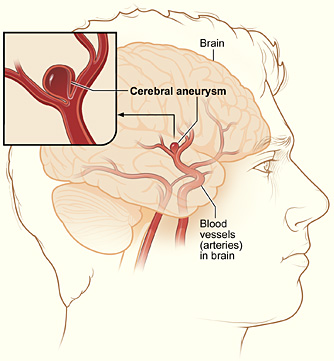Updated September 9, 2020
Another name for a stroke is a cerebral infarction or a cerebrovascular accident (CVA). The blood vessels that bring blood to the brain get restricted – due either to a blockage or damage.
One way to think of a stroke is that it’s like a heart attack except in the brain.
Types and Causes of Stroke
Aneurysms, trauma, atherosclerosis, and even congenital anomalies can all result in an interruption to the blood flow to the brain.

Ischemic stroke
Most strokes (~87%) are ischemic strokes, which is what it’s called when the blood flow is blocked in the head or neck.
Atherosclerosis (buildup of cholesterol inside the blood vessel) can narrow the arteries and cause clots to form. A clot blocking the artery where it formed is a thrombus. If it breaks off from elsewhere in the body it’s an embolism, and it can become lodged in a smaller vessel or against an atherosclerotic plaque. Embolisms can also be due to clots created by irregular heart rhythms, clotting disorders, and drug use.
Hemorrhagic stroke
About 10% of strokes are hemorrhagic, caused by a bleed due to a tear in the blood vessel.
The hemorrhagic stroke can be intracerebral (caused by vessel rupture within the brain) or subarachnoid (caused by a bleed between the brain and its membrane).
Some congenital malformations of the blood vessels in the brain can rupture and cause a stroke. Hypertension can cause dilation of the vessels, and then aneurysm (a ballooning and tear of the vessel).

Mini-stroke
In some instances, the blockage of the vessel lasts less than 5 minutes before restarting again. This is referred to as a transient ischemic attack (TIA), or a mini-stroke. Symptoms only occur for an hour or two and then the person feels normal again. TIA is considered a harbinger of a future full stroke (within a year for one-third of people who experience them, within 3 months in 10-15%) unless preventative steps are taken.
All strokes require medical care.
Risk Factors
The main contributing factors to stroke are:
- Smoking
- High blood cholesterol levels
- Hypertension
- Being overweight
- Diabetes
- Physical inactivity
- Alcohol use
- Circulation problems and atrial fibrillation
- Being over 55 years old
- Being male
- Being non-Caucasian
- Having a family history of stroke and/or heart disease
- Being born with a patent foramen ovale (hole in the heart)
- Having fibromuscular dysplasia
Signs of stroke
The symptoms of a stroke come on suddenly. Exactly which symptoms occur depends on which blood vessel is affected.
- Numbness or weakness in the face or limbs, especially if it’s only on one side
- Confusion, trouble speaking, or difficulty understanding speech
- Vision problems
- Dizziness or loss of balance and/or coordination
- Severe headache
Women sometimes have unique symptoms that can include:
- Nausea
- Face pain
- Chest pain
- Trouble breathing
- Hiccups
- Palpitations
Preventing stroke
- Stop smoking
- Drink alcohol in moderation, if at all
- Manage heart disease, including diabetes and hypertension
- Lower your total cholesterol levels to less than 200 mg/dL
- Eat a healthy, balanced diet including essential vitamins and antioxidants
- Exercise and maintain a healthy weight
Dietary changes
Dietary modification, along with exercise, is one of the easiest ways to reduce the risk of stroke. Eat a balanced diet with omega-3 fatty acids, low sodium, no added sugar, and high in fruits and vegetables.
Antioxidants
Antioxidants are important components of the human diet that scavenge free radicals formed from, among other chemical reactions in the body, the production of certain forms of cholesterol. More than one study has reported that higher dietary intake of antioxidants was associated with lower stroke risk in post-menopausal women.
Antioxidants include:
- Beta-carotene and its metabolite vitamin A
- Vitamin C
- Vitamin E
- Lutein
- Lycopene
- Selenium
Foods that contains antioxidants include:
- Nuts
- Grains
- Poultry
- Fish
- Tomatoes
- Fruits (including citrus and watermelon)
- Green leafy veggies
- Fortified foodstuffs
Flavinoids
Dark chocolate (cacao), which is high in cocoa solids and low in milk fats, has been associated with a reduced risk of stroke due to an interruption of clotting by flavanols (e.g., catechins), though the necessary intake may be higher than moderation would presume. Flavinoids (flavan-3-ols) are also found in red wine and green tea. They also occur as flavanones in citrus fruit and have shown protection against stroke women.
Exercise
Studies have shown that walking 30 minutes per day can cut the risk of stroke by 40%. Exercise also helps strengthen the heart and reduce weight, which can strain the cardiovascular system. Maintaining a healthy weight can also stave off diabetes and hypertension, which increase the risk of stroke
Disclaimer: This page is for informational and learning purposes only. It is not meant to diagnose or treat any medical condition and should not be used in place of speaking with a medical doctor or seeking treatment.
Aliconia Publishing, LLC and the author make any and all attempts to ensure the accuracy of the presented facts. If you find an issue with any information on these pages, please use the Contact page to alert us. The content is subject to change based on new information or to be updated with additional facts. The date of last change is stated under the main header.
Discover more from Just Facts
Subscribe to get the latest posts sent to your email.